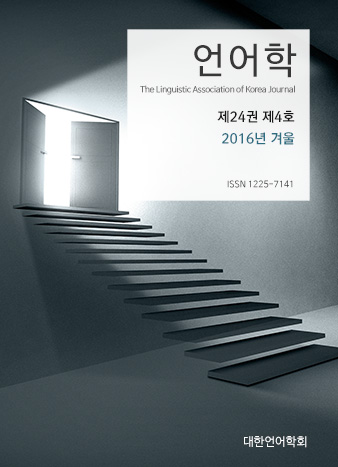대한언어학회 전자저널

-
An Alternative Approach to Realizations of the Medial [nt] Cluster in English
-
Boundary and pitch effects on the perception of Korean alveolar nasal
-
Corpus-Based English Grammar Instruction in a Korean College Context Korean College Context
-
A Study on the Relationship between Self-Efficacy Beliefs and Comprehension in English Reading
Abstract
Keywords
# michin # phokphwung # collocational environment # collocate # A CONCEPT FOR ITS OPPOSITE metonymy # A CATEGORY FOR ITS PROPERTY metonymy
References
- 강현화. (1998). [체언+용언] 꼴의 연어 구성에 대한 연구. 사전편찬학연구, 8, 191-224.
- 김진해. (1999). 연어(collocation)의 의미 관계에 대하여. 한국어의미학, 4, 239-279.
- 임근석. (2011). 한국어 연어 연구의 전개와 쟁점에 대하여. 국어학, 61, 359-387.
- 임유종. (2011). 연어의 개념과 범주 한정의 제 문제. 국제어문, 36, 145-181.
- 임홍빈. (2005). 한국어 연어의 개념과 그 통사ㆍ의미적 성격. 국어학, 39, 279-320.
- 이윤경. (2009). 코퍼스 기반 한국 대학생의 어휘적 연어 능력 연구. 현대문법연구, 57, 245-266.
- 이은경. (2005). 명사를 중심으로 하는 문법적 연어 구성. 한국어의미학, 17, 177-205.
- 최형강. (2012). 연어의 논항과 의미역 -“명사+부리다” 연어 구성을 중심으로-. 한국어학, 57, 357-382.
- Bednarek, M. (2008). Semantic preference and semantic prosody Re-examined. Corpus Linguistics & Linguistic Theory 4.(2), 119-139.
- Bublitz, W. (1995). Semantic prosody and cohesive company: Somewhat predictable. General and Theoretical Papers 247, 1-23.
- Radden, G. & Kovecses, Z. (1999). Towards a theory of metonymy. In K. Panther & G. Radden (Eds.), Metonymy in language and thought (pp.17-59). Amsterdam & Philadelphia: John Benjamins Publishing Company.
- Wentworth, H. & Flexner, S. (1967). Dictionary of American Slang. New York: Crowell.